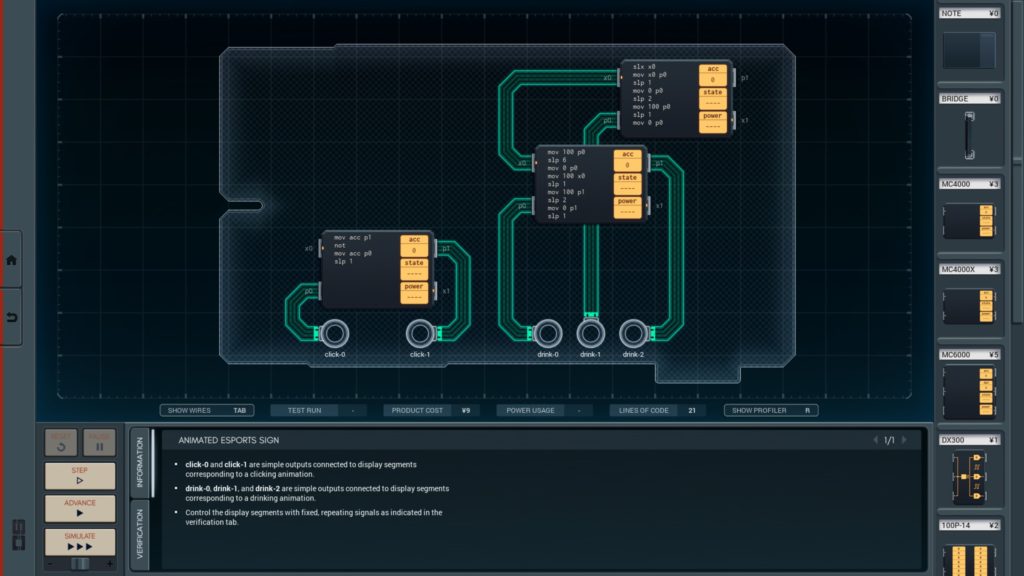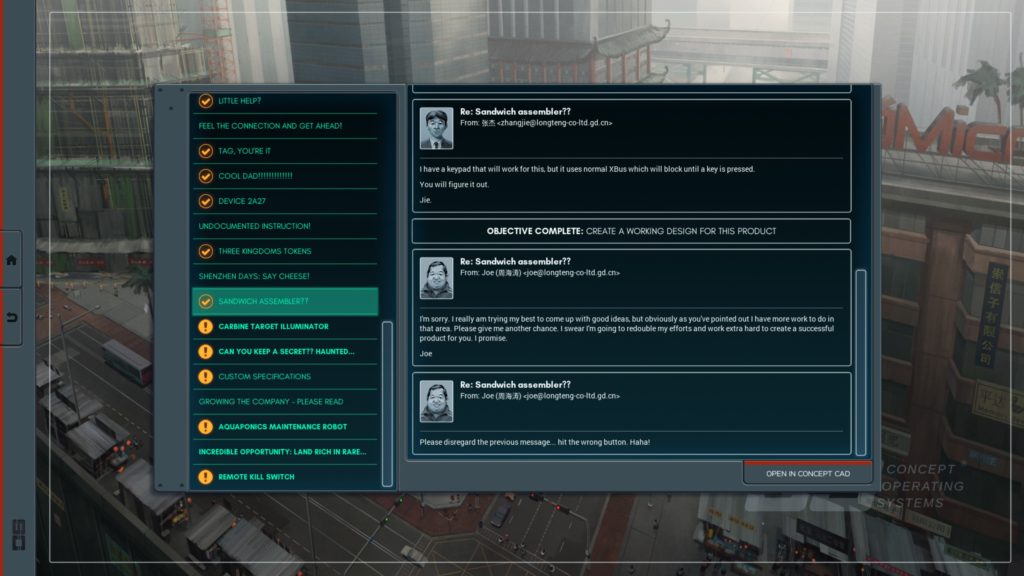
Taking up yet another Zachtronics game to play makes me feel like a glutton for punishment. Years after I said I would probably never play this title yet here I am. Not only did I hugely enjoy this, much more so than I ever did with TIS-100, I’m also shocked that I managed to complete just about all of the puzzles in it on my own, at least those in the main campaign. Those in the bonus campaign are another order of difficulty entirely. I’m pretty stoked that I managed the feat even if some of my solutions rate rather poorly against the average.
The premise in Shenzen I/O is that you’re a British engineer who, having learned that things just aren’t being made in the UK any longer, decide to take up a job in Shenzen, China. Your company makes a variety of specialized electronics products for clients, and your job is to put the required components together and write the code that makes them work. One of the most amazing things about this game is that it comes with a manual hat purports to be a new employee’s handbook that you’re supposed to print out and keep in a three-ring binder. It contains role-playing elements like a welcome letter from your employer and your visa application for China in addition to being a reference for the fictional assembly language that is used in the game. You also need it for the specifications of the components available to you and many of the later puzzles ask you to refer to the diagrams and charts in it that describe what is needed for particular products.

Unlike TIS-100, this game actually has real graphics. The game emulates your work desktop and you communicate with your bosses and colleagues by email. Your assignments include making the led signs that are given out at concerts, programming a sandwich making machine and so on. Your colleagues will be suitably nervous about working on projects such as an attachment for a gun that illuminates the target based on distance. You do get more components to play with over the course of the game but there aren’t really that many of them. Finally there is mahjong-based solitaire game included that is quite a bit harder than the usual solitaire we know and makes for a nice way to procrastinate when you hit a seemingly unsolvable problem and just want to put off thinking about it.
Since I can actually complete this on my own, it’s fair to say that this is significantly easier than TIS-100. Even the fake assembly language used is simpler and it’s much easier to synchronize timing between different processing units. The limited number of ports available on each processing unit constrains the problem space to a more manageable size and actually acts as a kind of hint as to what is possible. In many cases, the problem is easily solved if you’re willing to throw more processing units at it, though you are limited in the space available on the circuit board. Generally though the problems are solvable with surprisingly few processing units if you understand how to properly use the other components that are available. I especially love how the puzzles are usually small enough that you can keep the whole thing in your head. It’s amazing how effective it is to just walk away from a puzzle after having been stumped for a while to ponder on it while doing other things. Invariably you’ll come up with some new approach to try.

Of course one should not be tempted to think that is anything like real programming of electronic devices. The problem space here is highly abstracted and the extremely tight memory and line limitations are wildly unrealistic. This is also very much a case of building to the test as the specifications just aren’t precise enough. It’s terrible how much of a hack the solutions have to be and how fragile they would be in anything close to real world conditions. But it does foster the kind of problem-solving and thinking outside the box mindset that would be useful. It also feels great to at least pretend to be an electronics engineer who makes all kind of cool gadgets. I even like the story elements with plenty of ribbing between colleagues but refrains from anything dramatic.
Maybe one day I will come back to this and actually put serious effort into cracking the bonus campaign. But I took a brief look at it and it’s seriously hard so I don’t hold out much hope. In the meantime, this is fantastic programming game that I would recommend to anyone who loves puzzle games. I really like that Zachtronics has chosen to tone down the difficulty of their games, so that while they are still challenging, they do now expect players to complete all of the puzzles in the main game. At the same time, the much harder puzzles, meant to really challenge the most dedicated fans, are put in as a bonus.
One thought on “Shenzen I/O”